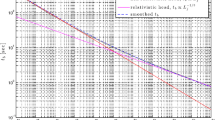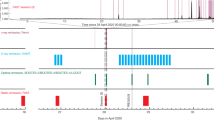Abstract
INTERGALACTIC magnetic fields (IGMFs) can be produced by a number of mechanisms, but are expected to be weak and have not so far been detected. 'Primordial' magnetic fields might have been produced in the very early Universe, either by quantum fluctuations during the 'inflationary' period1,2 or through the decoupling transitions of the fundamental forces3,4. The much later ejection of magnetized plasma into intergalactic space from galaxies and active galactic nuclei should also produce IGMFs, though it is possible that some fraction of the Universe retains its 'primordial' field5. Previous studies6 have placed an upper limit of 10 -9 gauss on the strength of an IGMF (with a coherence length of 1 Mpc), but the strength may be much less than this, posing a formidable challenge to current observational capabilities. Here I propose a highly sensitive method for probing weak IGMFs by exploiting their effect on the arrival times of γ-rays from extragalactic sources. The delay in arrival owing to the action of intergalactic magnetic fields on electron cascades caused by scattering of the γ-ray photons might be used to measure fields as weak as 10 -24 gauss. I suggest that this effect may already have been seen in the arrival times of high-energy photons after the main burst of a γ-ray burster7.
Similar content being viewed by others
References
Ratra, B. Astrophys. J. 391, L1–L4 (1992).
Turner, M. S. & Widrow, L. M. Phys. Rev. D37, 2743–2754 (1988).
Cheng, B. & Olinto, A. V. Phys. Rev. D50, 2421–2424 (1994).
Vachaspaty, T. Phys. Lett. B265, 258–261 (1991).
Thomson, R. C. & Nelson, A. H. Mon. Not. R. astr. Soc. 201, 365–383 (1982).
Kronberg, P. P. Rep. Prog. Phys. 57, 325–382 (1994).
Hurley, K. et al. Nature 372, 652–654 (1994).
De Jager, O. C., Stecker, F. W. & Salamon, M. H. Nature 369, 294–296 (1994).
Protheroe, R. J. & Stanev, T. in Proc. Palaiseau Workshop ‘Towards a Major Atmospheric Čerenkov Detector’ (eds Fleury, P. & Vacanti, G.) 103–114 (Editions Frontieres, Gif-sur-Yvette, 1992).
Zdiarski, A. J. Astrophy. J. 335, 786–802 (1988).
Kniffen, D. A. et al. Astrophys. J. 411, L133–L136 (1993).
Kouveliotou, C. et al. Astrophys. J. 413, L101–L104 (1993).
Mohanty, G. et al. in Proc. 23rd Cosmic Ray. Conf. Vol. 1 (ed. Leahy, D. A.) 440–443 (Univ. Calgary Press, Calgary, 1993).
Paczyński, B. Comm. Astrophys. 16, 241–243 (1992).
Sommer, M. et al. Astrophys. J. 422, L63–L66 (1994).
Longair, M. S. High Energy Astrophysics Vol. 1 88–130 (Cambridge Univ. Press, 1992).
Paczyński, B. Astrophys. J. 308, L43–L46 (1986).
Pare, E. in Proc Calgary Workshop ‘Towards a Major Atmosphere Čerenkov Detector II’ (ed. Lamb, R. C.) 250–259 (Iowa State Univ., Calgary, 1993).
Aharonian, F. A., Coppi, P. S. & Völk, H. J. Astrophys. J. 423, L5–L8 (1994).
Author information
Authors and Affiliations
Rights and permissions
About this article
Cite this article
Plaga, R. Detecting intergalactic magnetic fields using time delays in pulses of γ-rays. Nature 374, 430–432 (1995). https://doi.org/10.1038/374430a0
Received:
Accepted:
Issue Date:
DOI: https://doi.org/10.1038/374430a0
- Springer Nature Limited
This article is cited by
-
Cosmological magnetic fields: their generation, evolution and observation
The Astronomy and Astrophysics Review (2013)
-
Gamma-ray bursts in the Swift-Fermi era: Confronting data with theory
Science China Physics, Mechanics and Astronomy (2010)
-
High-energy γ-ray emission from gamma-ray bursts — before GLAST
Frontiers of Physics in China (2008)
-
Cosmology and VHE gamma ray astrophysics: connections and perspectives
Astrophysics and Space Science (2007)
-
Time trials test the field
Nature (1995)





